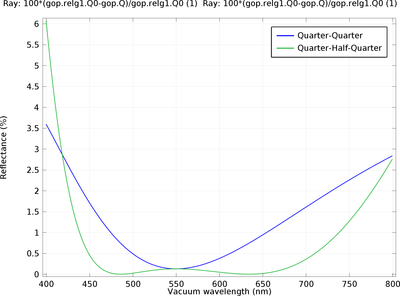Antireflective Coating with Multiple Layers
Application ID: 19279
Anti-reflective coatings are frequently used in optical systems to reduce the amount of stray light produced when a beam of light crosses from one medium into another medium with a different refractive index. The simplest example of an anti-reflective coating is a quarter-wavelength layer, in which the thickness of a monolayer dielectric film is adjusted to be one fourth of the optical wavelength. Although a single-layer coating can reduce the reflectance to zero for light at a specific wavelength and angle of incidence, the reflectance can be substantially larger for other wavelengths. One possible solution is to use a multilayer coating that gives consistently low reflectance over a wider spectral band.
In this tutorial, light crosses a boundary between two media with different refractive indices at normal incidence. The reflectance of two different multilayer coatings is compared over a wide spectral range: a quarter-quarter coating (two layers), and a quarter-half-quarter coating (three layers). The quarter-half-quarter coating is shown to have more consistently low reflectance across most of the visible spectrum.

この model の例は, 通常次の製品を使用して構築されるこのタイプのアプリケーションを示しています.
ただし, これを完全に定義およびモデル化するには, 追加の製品が必要になる場合があります. さらに, この例は, 次の製品の組み合わせのコンポーネントを使用して定義およびモデル化することもできます.
アプリケーションのモデリングに必要な COMSOL® 製品の組み合わせは, 境界条件, 材料特性, フィジックスインターフェース, パーツライブラリなど, いくつかの要因によって異なります. 特定の機能が複数の製品に共通している場合もあります. お客様のモデリングニーズに適した製品の組み合わせを決定するために, 製品仕様一覧 を確認し, 無償のトライアルライセンスをご利用ください. COMSOL セールスおよびサポートチームでは, この件に関するご質問にお答えしています.
